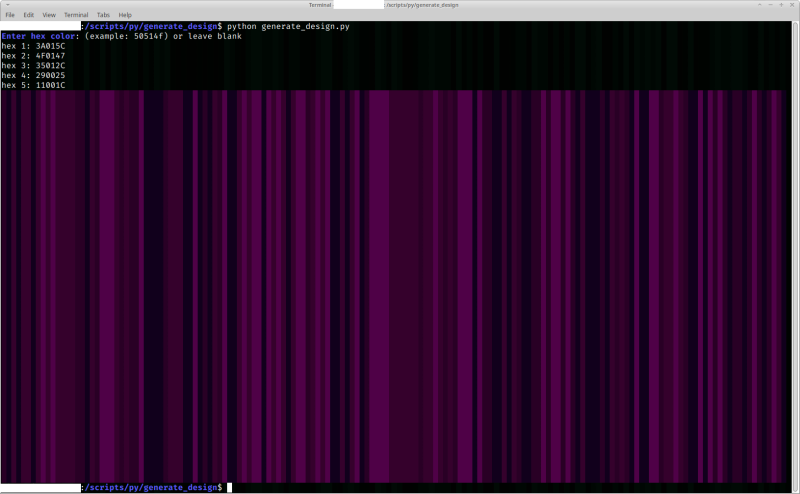Generate random design which displays in terminal emulator
The human-readable Unix shebang #! translates to the magic number 0x23 0x21. Based on the shebang line #!/usr/bin/env python, the env shell command interprets the generate_design.py text file as a Python app.
>>> hex(ord('#'))
'0x23'
>>> hex(ord('!'))
'0x21'>>> __doc__
'Generate random colored background design.'
>>> generate_design.__doc__
'Generate random background design.'__doc__string contains module's documentationgenerate_design.__doc__string contains the function's documentation
from random import randrangeThe random.randrange() method is used to generate a random number from 1 to 5, in order to randomly select one color from the scheme.
def generate_design():The block keyword def starts the definition and organization of the function's code; the generate_design() method's code block.
print('\x1b[1;34mEnter hex color\x1b[0m: (example: 50514f) or leave blank')
hex1 = input('hex 1: ').upper() or '000000'
hex2 = input('hex 2: ').upper() or '000000'
hex3 = input('hex 3: ').upper() or '000000'
hex4 = input('hex 4: ').upper() or '000000'
hex5 = input('hex 5: ').upper() or '000000'The input() builtin function returns a prompt for user input. The following is an example of such input:
Enter hex color: (example: 50514f) or leave blank
hex 1: 020202
hex 2: 0d2818
hex 3: 04471c
hex 4: 058c42
hex 5:Since the hex 5: input was left blank, hex5 will default to '000000'
hex_strs = hex1 + hex2 + hex3 + hex4 + hex5Hex color code inputs are all concatenated into a single string.
'0202020d281804471c058c42000000'hex_pairs = []
n = 0
for i in range(0, 5):
hex_pairs.append([hex_strs[n:n+2], hex_strs[n+2:n+4], hex_strs[n+4:n+6]])
n += 6n is used to set the first index point in the long string for the start of each hex pair list. Slice notation is used to separate each 6-character code into three items. For example, the hex color code '058c42' splits to ['05', '8c', '42'], which represents a specific color.
[['02', '02', '02'], ['0d', '28', '18'], ['04', '47', '1c'], ['05', '8c', '42'], ['00', '00', '00']]ascii_nums = []
for i in range(0, 5):
ascii_nums.append([int(hex_pairs[i][0], 16), int(hex_pairs[i][0], 16),
int(hex_pairs[i][0], 16)])Hex pairs are converted to ASCII code decimal numbers, as demonstrated below:
>>> int('05', 16)
5
>>> int('8c', 16)
140
>>> int('42', 16)
66[[2, 2, 2], [13, 40, 24], [4, 71, 28], [5, 140, 66], [0, 0, 0]]The ASCII value numbers will used for color formatting: f'\x1b[48;2;5;140;66m \x1b[0m'.
\x1b[sequence escapes the color formatting.48;2;sequence sets formatting to background color.5;140;66msequence sets RGB color values.\x1b[0msequence sets color to default.
colors = [] # color scheme strings
for i in range(0, 5):
colors.append(f'\x1b[48;2;{ascii_nums[i][0]};{ascii_nums[i][1]};{ascii_nums[i][2]}m \x1b[0m')
color_strings = ''
for i in range(0, 160):
color_strings += colors[randrange(0, 5)]
for i in range(0, 40):
print(color_strings)The f-string f'\x1b[48;2;{ascii_nums[0][0]};{ascii_nums[0][1]};{ascii_nums[0][2]}m \x1b[0m' background color formats a single space. The sequence 48;2; is for background color modification, followed by 13;40;24, which sets RGB values, for example.
The first for loop generates a list which is assigned to colors variable. A list of formatted background-colored spaces.
The second for loop interates the color_pattern += colors[randrange(1, 5)] instruction which appends a random background-color space to the color_pattern attribute. The randrange(1, 5) call returns an integer from 1 to 5 which is used to pick a random color index.
The third for loop simply repeats the generated random pattern stored in color_pattern to the extent of 40 identical lines.
if __name__ == '__main__':
generate_design()The final if block executes the generate_design() method of the script runs as a standalone app. For example, if this app was imported into another app, its __name__ would no longer be __main__, so generate_design() would not execute unless it was called.
